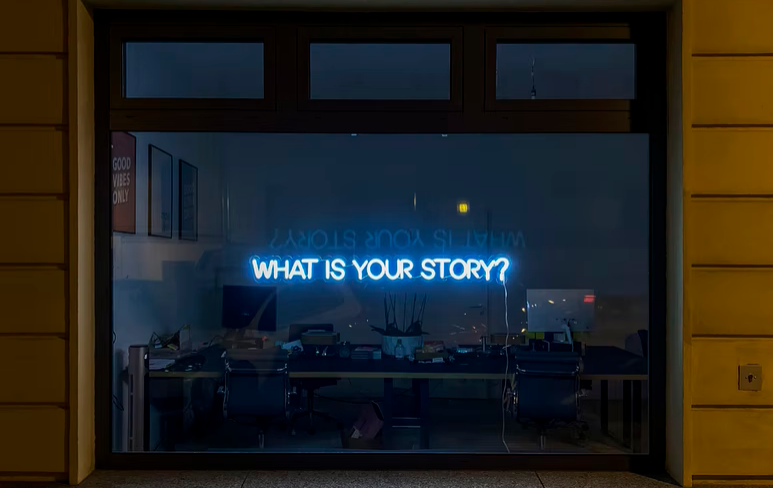This is your must-read guide on all things business storytelling including how to write a memorable brand, product, or customer story.

What is storytelling in business?
Stories. They’re everywhere. And they’ve been around forever—literally.
Parents tell them at bedtime, applicants use them at job interviews, teachers share the occasional anecdote, and leaders incorporate them in speeches. Savvy businesses make use of them too.
- Buying milk? The packaging will weave a story about healthy, happy cows that are free to graze in idyllic surroundings like the Alps.
- Looking for toothpaste? This brand wages war on pesky bad-breath causing bacteria. The result: Minty-fresh breath that can land you a date with the person of your dreams.
- Need a mattress? The sales copy will highlight how new mattress technology solved Paul’s back pain problem and gave him the best sleep of his life. Now he’s extra productive at work every single day!
In other words, business storytelling is simply an engaging way to communicate messages or share information using the narrative structure.
Storytelling marketing: Where can you find it?
Storytelling is more than just a marketing buzzword. It’s proven to be effective at breaking through the noise and has the great advantage of being ‘sticky’. Fun fact: 63% remember stories while only 5% remember statistics! In fact, that’s one of the primary reasons why brands tell stories.
So what kind of storytelling is there in marketing?
Product storytelling
This involves telling the story of a product or service like why you made it, the struggles you overcame to reach this point, the benefits for customers, and the impact your product / service has made on the lives of your customers, society, environment. You might come across this on product or landing pages, marketing emails and newsletters, or on a brand’s blog.
Brand storytelling
A brand story goes beyond your products and services. It’s about who you are but also your values, that is what you stand for. You use the story format or a narrative to connect your brand with both leads and customers.
That’s why brand stories can be found across marketing touchpoints and in various forms. For example: A business’ origin story or ‘about us’ page; packaging copy; and digital touch points including your website or in the form of content like articles, e-books, case studies, videos and podcasts and so on.
Customer storytelling
This is all about creating an environment where customers want to share the positive experiences they had with your brand or business with others. Doing so provides you with a great opportunity to mine awesome stories, which you can use for social proof, to earn consumer trust, and further market your brand to like-minded prospects.
Customer stories can be found in customer care experiences or anywhere where you interact with customers; in testimonials from happy clients; case studies; and complex sales transactions, whereby an in-depth conversation is required. You’ll also find it on social media (photos and videos).
In short: Your business’ story is embedded in your culture, it guides how you interact with customers, and influences how you present yourself to (and are perceived by) the public. And as you now know, you don’t have total control over your brand story. Prospects, customers, employees, and business partners play a role in the evolution of your story but also how that story gets told.

Must-haves for a great brand story
Truth
Unlike fairy tales, business storytelling isn’t fictitious. Corporate stories are based on facts and truth. They shouldn’t be made up or invented. Instead, they naturally take shape over the months of planning and years of running your business. They are your values, hopes and dreams, shared memories and experiences, successes and failures—all of it!
Relevance
We can tell all kinds of stories but let’s be honest, if it’s not what people care about, it has no meaning. Stories that work are interesting and pertinent to your target audience.
Originality
A great story isn’t recycled. It’s not someone else’s nor is it a copy of what others are doing. It’s unique to your brand, your history, your motivations, and your experiences. No two brands or businesses are alike, so there’s no reason for your business story to be anything but unique.
Purpose
Sales and marketing materials have a job to do. They aren’t written to be a placeholder. They have to inform, educate, entertain, engage, persuade—or satisfy any combination of those goals. Stories allow you to connect with your readers on a personal level that’s just not possible purely with facts and figures.
Emotion
The best stories elicit feelings from readers. (That’s the whole point of marketing writing.) For instance: Your deodorant neutralizes odors and keeps bacteria at bay for up to 24 hours but it also gives users confidence to go about even their most active of days. That assurance – the fact that users don’t have to worry about smelling bad – is what appeals to prospects on an emotional level.
Clarity
The secret to effective business storytelling is to be focused and clear. At the end of the day, when you keep things simple, you get things done. If you try to stuff as many points and details as possible into your writing, the core story actually gets lost.

The advantages of corporate storytelling
In today’s environment, where it’s becoming more challenging to engage our target audience, one approach stands out: Business storytelling. Compared to traditional marketing writing, storytelling is a particularly effective way of communicating—and brand building. Here’s why.
It helps you stand out
In a world where it’s hard to break through the noise, stories are innocuous. People ignore and even block ads but stories aren’t annoying, invasive, or overwhelming. In fact, we’re naturally drawn to stories.
It’s memorable
Stories are appealing, entertaining, and very often relatable. They’re also memorable. In fact, it’s been found that, when woven into narratives, people remember information up to 22 times more than when it’s just the facts alone. That’s an incredible difference – enough to be a ‘make or break’ scenario for brands fighting to break through the noise and boost awareness.
It makes you approachable
Facts and figures don’t help you form a relationship with readers – stories do. Stories pull back the curtain to show who you are beyond the name and fancy logo. Stories are what people relate to. In short, storytelling is what humanizes your brand and that makes you more likeable, real, worthy of trust, and of course your audience more receptive to your messages.
Stories are persuasive
Stories have the ability to bring us together on an emotional level as we share concerns, feel empathy, laugh, and see ourselves (or who we’d like to be) in the hero of your story. And it’s precisely those emotions that drive people to take action.
How do you tell a good story?
Having said all that, stories don’t always work.
To be effective, you have to strike the right balance of data and story—only then will you get people to care. That’s why business storytelling truly is an art and a science.
That leads to the question: How do you piece together your story, so that it makes an impact? What do you have to focus on?
1. Understand your audience
Whether it’s your ‘about us’ page, landing pages, or articles on your website, you need to know who you’re writing for. Ask yourself, “Who is going to read this?”
You need to know what makes your audience tick. Equally, you also need to speak their language. For example: Business storytelling for a B2B audience won’t necessarily be the same as storytelling for individual consumers.

2. Structure and sequence
Every story has a beginning, a middle (with conflict and climax), and an end but you might not always want to start at the beginning and you don’t always want to describe every last detail. You have to be engaging and keep readers’ interest, so you can’t afford to be boring. You also have to make sure that what you write follows a logical flow—and makes sense.
3. Streamline your message
In business storytelling, there’s always a goal.
- Are you trying to communicate how your product solves a customer’s problem?
- Do you want to share your origin story and why you started this business?
- Is the goal to highlight why customer A loves your product or service?
Whatever it is, what you write has to support that goal. Your story – the marketing message you’re trying to convey – can’t be all over the place.
4. Balance data with story
Storytelling is more than what you say – it’s also about what you do as a business. But it’s the ‘hows’ and ‘whys’ that contain the emotional hook that make people care. In other words, you have to balance facts and figures with context. That’s what means something to people. That’s how to be persuasive.
5. Keep only what you need
Edit without mercy, as they say. Your story should only be as long as needed to communicate what you set out to communicate. Ideally, it shouldn’t be too long nor too short. Stick to what matters and what is important.